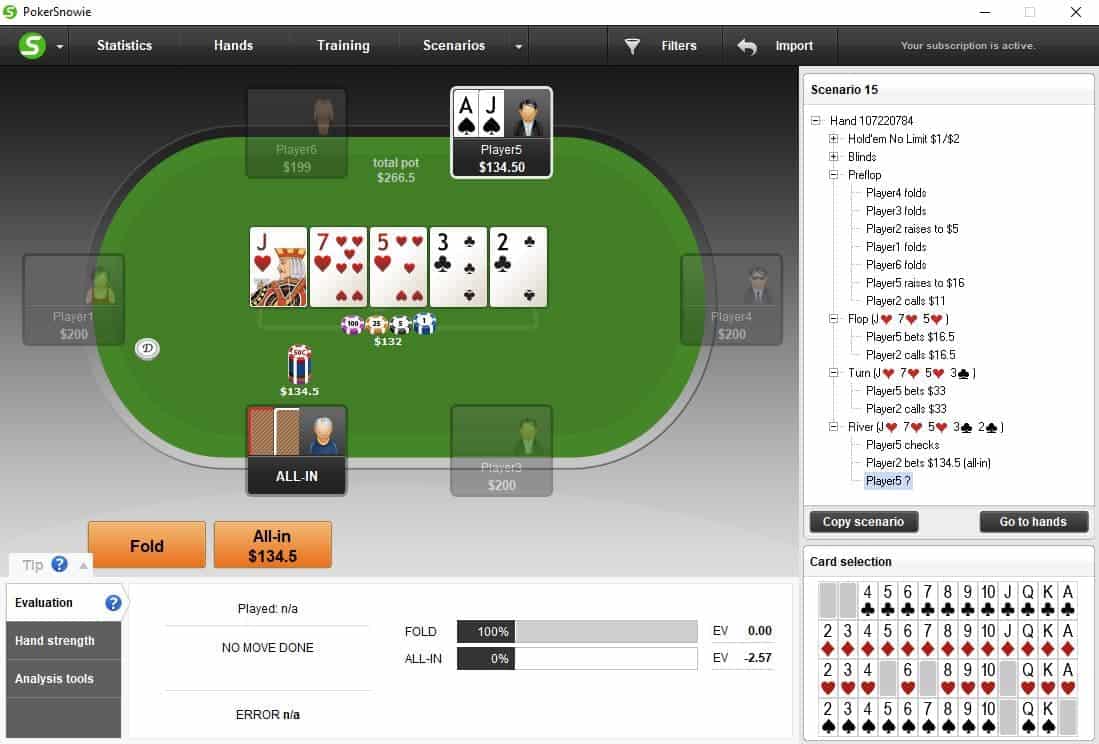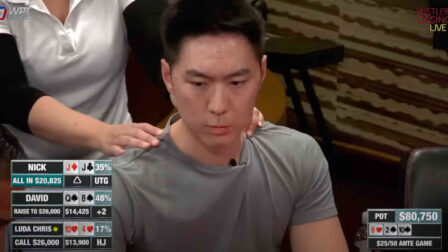BLUFF CATCHING: How, When and Why?

8 minutes
Last Updated: March 19, 2024
Bluff Catching Strategy and Tips
Bluffing is an essential part of poker, and we all love pulling a good bluff and winning a pot with pure air. Being on the other side of that coin, though, isn’t nearly as entertaining.
When your opponent fires a big bet on the river, and you have a hand that can only beat the bluff, what do you do?
This article will deal with the fine art of bluff catching. While it probably won’t give you a complete solution to the bluff catching puzzle, it should help you understand some of the core underlying principles to fall back on when considering a thin call.
Table of content
Bluff Catching in a Nutshell
The term “bluff catching” is used to describe situations where you’re making a call with a hand that pretty much has no chance of beating any of your opponent’s value hands.
This can be very situational as far as your particular holdings are concerned since the absolute hand values can become quite irrelevant.
For example, if you have a flopped set on a four-flush board, and your opponent is betting big on the river, he’s likely not doing it with two pair. In most instances, he’ll either turn over a flush, which beats our set, or absolute air.
In both of these scenarios, our absolute hand strength is not as significant – we just need a hand strong enough to beat the bluffing range (which won’t be that strong by definition).
In other scenarios, we might be tempted to look our opponent up with a hand as weak as King or Queen high. While rare, these situations do happen, and when you make that great call, it is one of the best feelings in poker.
But how do you get to a point where you can actually make these calls based on more than just a hunch?
Back to Basics: Ranges & Range Advantage
Making those tough hero calls can seem like a very advanced play (and it sometimes is), but it usually starts with the basics, i.e. properly putting your opponent on a range of hands (based on positions, vpip poker stats and ofter info) and working from there.
The only way to efficiently bluff catch is if you have some idea about what types of hands the other player is likely to have.
Let’s look at an example that demonstrates this concept pretty well. Keep in mind, though, that when bluff catching, you will be wrong some of the time, but that is perfectly normal.
This particular area of the game is somewhere between skill and art, which means that you will have to deal with some bad judgments along the way. It also means that you shouldn’t be actively looking for bluff catching spots just for the sake of it.

Get PokerSnowie FREE Trial and try it yourself!
In this scenario, we raise from UTG and get 3-bet by the small blind. At this point, we can already assign them a pretty strong range – players don’t often bluff from the small blind, as it is probably the worst position to do it from, especially against an early position raise.
The flop comes with one over-card to our pocket pair, but the 9h is really not important – our opponent doesn’t have many (if any) nines in their range when they 3-bet from the small blind. So, the flop call is fairly standard.
The 6h on the turn doesn’t change the board structure all that much. In fact, it is a card that is more likely to help us if we decided to call a 3-bet with a hand like 45s (although this would require a fairly wide UTG raising range) or float the flop with pocket 6s.
The only realistic way in which it could have helped the small blind (if they don’t have a big pocket pair already, of course) is by giving them a flush draw.
The river 3d is the ultimate brick and the SB player fires for one last time. As you can see, Poker Snowie suggests calling, so let us break it down.
This is a good spot to bluff-catch because the board ran clean and both the front and backdoor flush draws missed.
Even with a big pocket pair, our opponent might slow down on the river to control the size of the pot against our flopped or turned sets and try to bluff-catch themselves when we were the one on a draw and can now only win by bluffing.
On top of that, many players tend to over bluff in these situations, and if they keep betting with all their broadways, they will have more bluffs then they should and calling becomes a good option.
Of course, you’ll occasionally be shown pocket Aces or pocket Kings as well, but that’s all part of the game. If you back your decisions with proper hand reading and math, you will be good.
If you want, you can learn a bit more about it in poker lab review, and now, let’s jump to some specifics.
More Info the Better: Know Your Opponent
When trying to catch bluffs and keep the other player “honest,” it is of the utmost importance to only do it against players you know are capable of bluffing.
Constantly trying to catch someone who pretty much has it whenever they bomb the river is lighting money on fire. They won’t show up with a bluff just because you want them to, so always observe your opponents and make necessary adjustments.
In online poker, you can understand a lot about your opponents’ tendencies using different poker tools and stats. Their overall aggression, 3-bet tendencies, and W$SD can give you a pretty good idea about how likely someone is to try and pull a big bluff.
In live poker, you can rely on the previous hands you’ve seen the player play, their general demeanor at the table, and other tidbits.
In some games, you’ll find reckless players that you’ll have to bluff catch more often than others. Likewise, you’ll encounter rocks who never bet without goods.
So once again, observe your opponents and make adjustments based on their playing style, information is gold!
Value of Blockers for Catching Bluffs
Blockers play a big role in choosing hands that you want to call down. A lot of the time it is better to call with relatively weaker holding, just because it blocks your opponent value hands and do not block likely bluffs, compared to stronger hands that do not have these benefits.
As you probably know by now, blockers are the cards that make it impossible (or at the very least less likely) for your opponent to hold the nuts themselves.

Get PokerSnowie FREE Trial and try it yourself!
In this scenario, we’re dealt Ace-Jack before the flop, put in a 3-bet against a cutoff open and get a call. The board comes with three hearts, and we have that key card – the Ace of hearts so we can comfortably barrel the flop. The opponent calls and the turn bricks off with 3c.
You can comfortably bet again in this situation on the turn and chose to do that. The river is another brick, 2c.
You can go for a value bet or play deceptively and check, hoping that the opponent has missed whatever they were after and will try to win the pot by betting.
So you check, and they come out betting all-in, basically a pot size bet! This may look scary at first, but having an Ace of hearts is a huge deal.
Our opponent is unlikely to bet so big with anything weaker than a flush, and we know he does not have a nut flush, making this bet a bit suspicious (he might choose to bet smaller with lower flushes to get value from wider range).
This is where we can rely on the power of our blocker to make the call. Blocking the nuts and facing a big bet on the river after taking a deceptive line, we must call and expect to win more than enough to make this a profitable line.
In fact, you can see that given the action, Snowie is suggesting that calling here every time is the right move, since it has the highest EV.
Let’s see how that changes when we do not have an Ace of hearts.

It may come to your surprise, but PokerSnowie suggests folding in the same situation if you do not have the blocker, so you easily see the value of these cards.
Conclusion: Bluff Catching is Just another Segment of the Game
Contrary to video poker games, in Texas Holdem, you have many options to influence your hand, and bluff catching if one of them. Picking off a big bluff on the river is cool, but this shouldn’t be your primary goal when playing.
Instead, be mindful of good bluff catching spots and pick them off as they come along. In some sessions, you might have three or four of these situations in a short period of time. In others, you won’t get an opportunity to bluff catch even once.
Learning proper strategy can take some time, but with some experience at the tables, you will be able to recognize these spots and improve your judgment. There are plenty of poker training sites that can help you with this, so choose your way to improve and never look back!
Summary:
- Evaluate your opponent's actual range based on his action
- Consider your opponent’s tendencies because some players are more likely to bluff than others
- Make sure to take advantage of various stats to make better decisions when playing online
- Blockers play a big role in bluff catching, so call more when you block villain’s strong holdings
- Call more when all draws miss on the river because many players over-bluff in these spots




















